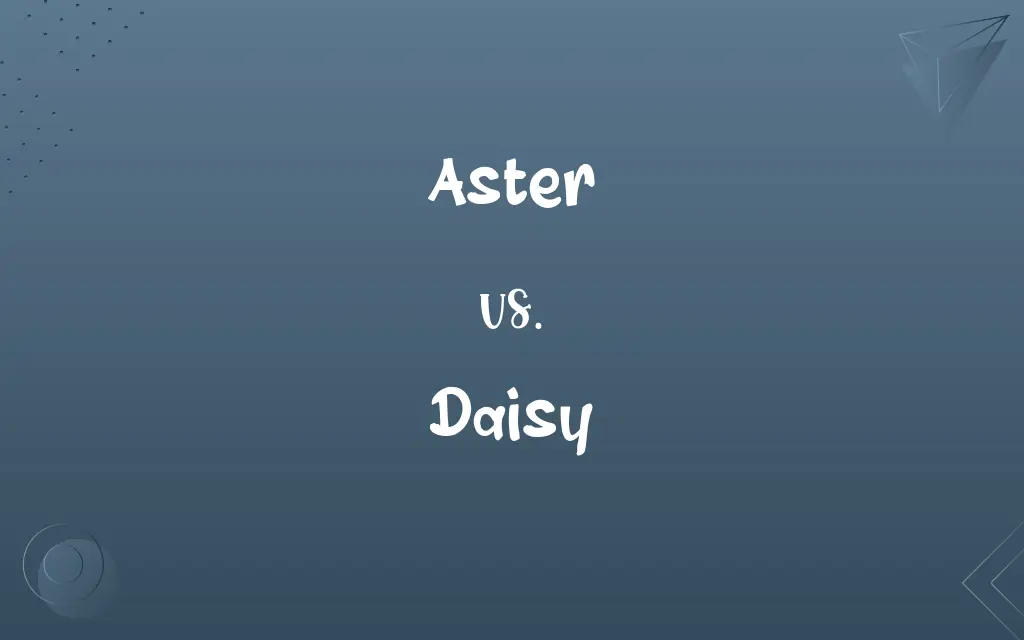Aster vs. Daisy: Know the Difference

By Shumaila Saeed & Dua Fatima || Updated on March 6, 2024
Aster flowers are known for their star-shaped blooms in late summer and fall, while daisies feature a classic, simplistic beauty with a disc center and surrounding petals year-round.

Key Differences
Asters bloom primarily in late summer to fall, offering a range of colors from blue to purple, symbolizing wisdom and valor. On the other hand, daisies are recognized for their timeless charm, often white with a yellow center, blooming from early spring through fall, symbolizing innocence and purity.
Dua Fatima
Mar 06, 2024
While asters can grow in a variety of conditions, they thrive in cooler climates and well-drained soil, making them perfect for autumnal gardens. Daisies, however, are more versatile, adapting to both sunny and partially shaded areas, making them a staple in many landscapes.
Shumaila Saeed
Mar 06, 2024
Asters are a favorite among butterflies and bees, serving as an important late-season pollen source. Conversely, daisies attract a wide range of pollinators throughout their longer blooming season, playing a crucial role in the ecosystem.
Shumaila Saeed
Mar 06, 2024
The aster's name is derived from the Greek word for "star," reflecting its star-like flower shape. Meanwhile, the name "daisy" comes from "day's eye," as its petals close at night and reopen at dawn, highlighting its daily rhythm with the sun.
Dua Fatima
Mar 06, 2024
Asters are part of the Asteraceae family but have been reclassified into various genera, which has made their classification a bit complex. Daisies, while also in the Asteraceae family, are generally less complicated taxonomically, with the classic daisy belonging to the genus Bellis.
Hifza Nasir
Mar 06, 2024
ADVERTISEMENT
Comparison Chart
Pollinator Attraction
Butterflies and bees in late season
Wide range, throughout blooming season
Shumaila Saeed
Mar 06, 2024
Taxonomic Complexity
Higher, due to reclassification
Lower, simpler classification
Shumaila Saeed
Mar 06, 2024
ADVERTISEMENT
Aster and Daisy Definitions
Aster
Known for late summer to fall blooming.
As summer ended, the asters began their display.
Shumaila Saeed
Mar 06, 2024
Daisy
Blooms from early spring through fall.
The daisies have been blooming since spring.
Dua Fatima
Mar 06, 2024
Aster
Symbolizes wisdom and valor.
She chose asters for the bouquet to symbolize her wisdom and courage.
Dua Fatima
Mar 06, 2024
Daisy
Attracts a wide range of pollinators.
The garden's daisies attracted butterflies, bees, and even birds.
Shumaila Saeed
Mar 06, 2024
Aster
A flowering plant with star-shaped blooms.
The garden was full of asters, adding color to the autumn landscape.
Hifza Nasir
Mar 06, 2024
ADVERTISEMENT
Daisy
Adaptable to sunny and partially shaded areas.
The daisies flourished both in the sunny and shaded parts of the garden.
Dua Fatima
Mar 06, 2024
Aster
Attracts butterflies and bees.
The asters in the yard buzzed with busy bees.
Shumaila Saeed
Mar 06, 2024
Daisy
Symbolizes innocence and purity.
The daisy chain she wore symbolized her innocence.
Hifza Nasir
Mar 06, 2024
Aster
Requires well-drained soil and cooler climates.
Asters thrive in the garden's cooler, well-drained corner.
Hifza Nasir
Mar 06, 2024
Daisy
A classic flower with a yellow center and white petals.
Daisies dotted the field like stars in the sky.
Shumaila Saeed
Mar 06, 2024
Aster
Any of various plants of the genus Aster or closely related genera in the composite family, having radiate flower heads with white, pink, or violet rays and usually a yellow disk.
Shumaila Saeed
Oct 19, 2023
Daisy
A widely naturalized Eurasian plant (Leucanthemum vulgare syn. Chrysanthemum leucanthemum) having flower heads with a yellow center and white rays. Also called oxeye daisy, white daisy.
Shumaila Saeed
Oct 19, 2023
Daisy
A low-growing plant (Bellis perennis) native to Europe and widely naturalized, having flower heads with white or pinkish rays. Also called English daisy.
Shumaila Saeed
Oct 19, 2023
Aster
(Biology) A star-shaped structure formed in the cytoplasm of an animal cell during mitosis, having raylike microtubules that surround the centrosome.
Shumaila Saeed
Oct 19, 2023
Aster
(biology) A star-shaped structure formed during the mitosis of a cell.
Shumaila Saeed
Oct 19, 2023
Daisy
A wild flowering plant Bellis perennis of the Asteraceae family, with a yellow head and white petals
Shumaila Saeed
Oct 19, 2023
Daisy
Many other flowering plants of various species, mostly among the asterids.
Shumaila Saeed
Oct 19, 2023
Aster
A genus of herbs with compound white or bluish flowers; starwort; Michaelmas daisy.
Shumaila Saeed
Oct 19, 2023
Aster
A plant of the genus Callistephus. Many varieties (called China asters, German asters, etc.) are cultivated for their handsome compound flowers.
Shumaila Saeed
Oct 19, 2023
Daisy
A genus of low herbs (Bellis), belonging to the family Compositæ. The common English and classical daisy is Bellis perennis, which has a yellow disk and white or pinkish rays.
Shumaila Saeed
Oct 19, 2023
Aster
A star-shaped figure of achromatic substance found chiefly in cells dividing by mitosis.
Shumaila Saeed
Oct 19, 2023
Daisy
Any of numerous composite plants having flower heads with well-developed ray flowers usually arranged in a single whorl
Shumaila Saeed
Oct 19, 2023
Aster
Any of various chiefly fall-blooming herbs of the genus Aster with showy daisylike flowers
Shumaila Saeed
Oct 19, 2023
Aster
Star-shaped structure formed in the cytoplasm of a cell having fibers like rays that surround the centrosome during mitosis
Shumaila Saeed
Oct 19, 2023
Repeatedly Asked Queries
What is the symbolism behind daisies?
Daisies symbolize innocence and purity.
Shumaila Saeed
Mar 06, 2024
Can asters grow in warm climates?
Asters prefer cooler climates but can adapt to warmer conditions with proper care.
Shumaila Saeed
Mar 06, 2024
How do asters and daisies attract pollinators?
Asters attract late-season butterflies and bees, while daisies attract a broad range of pollinators throughout their blooming season.
Shumaila Saeed
Mar 06, 2024
How do daisies contribute to the ecosystem?
Daisies attract a wide range of pollinators, supporting biodiversity.
Dua Fatima
Mar 06, 2024
What distinguishes the aster's appearance?
Asters have star-shaped flowers, often in shades of blue and purple.
Dua Fatima
Mar 06, 2024
Can daisies grow in shaded areas?
Daisies can adapt to partially shaded areas.
Hifza Nasir
Mar 06, 2024
What is the taxonomic classification of asters?
Asters have been reclassified into several genera, making their taxonomy complex.
Shumaila Saeed
Mar 06, 2024
What are the water requirements for daisies?
Daisies require moderate watering, being quite drought-tolerant once established.
Shumaila Saeed
Mar 06, 2024
What makes daisies unique in their growth habits?
Daisies are notably resilient and adaptable, flourishing in both sunny and shaded areas.
Shumaila Saeed
Mar 06, 2024
Can asters and daisies be planted together?
Yes, they can complement each other well in a garden, offering a prolonged blooming season.
Shumaila Saeed
Mar 06, 2024
Are daisies easy to grow?
Yes, daisies are versatile and can thrive in various conditions.
Shumaila Saeed
Mar 06, 2024
How long do daisy flowers last?
Daisy flowers can last from early spring through fall, depending on the species.
Dua Fatima
Mar 06, 2024
Do asters come in different colors?
Yes, asters can be found in various colors, including blue, purple, and pink.
Shumaila Saeed
Mar 06, 2024
Share this page
Link for your blog / website
HTML
Link to share via messenger
About Author
Written by
Shumaila SaeedShumaila Saeed, an expert content creator with 6 years of experience, specializes in distilling complex topics into easily digestible comparisons, shining a light on the nuances that both inform and educate readers with clarity and accuracy.
Co-written by
Dua Fatima








































































